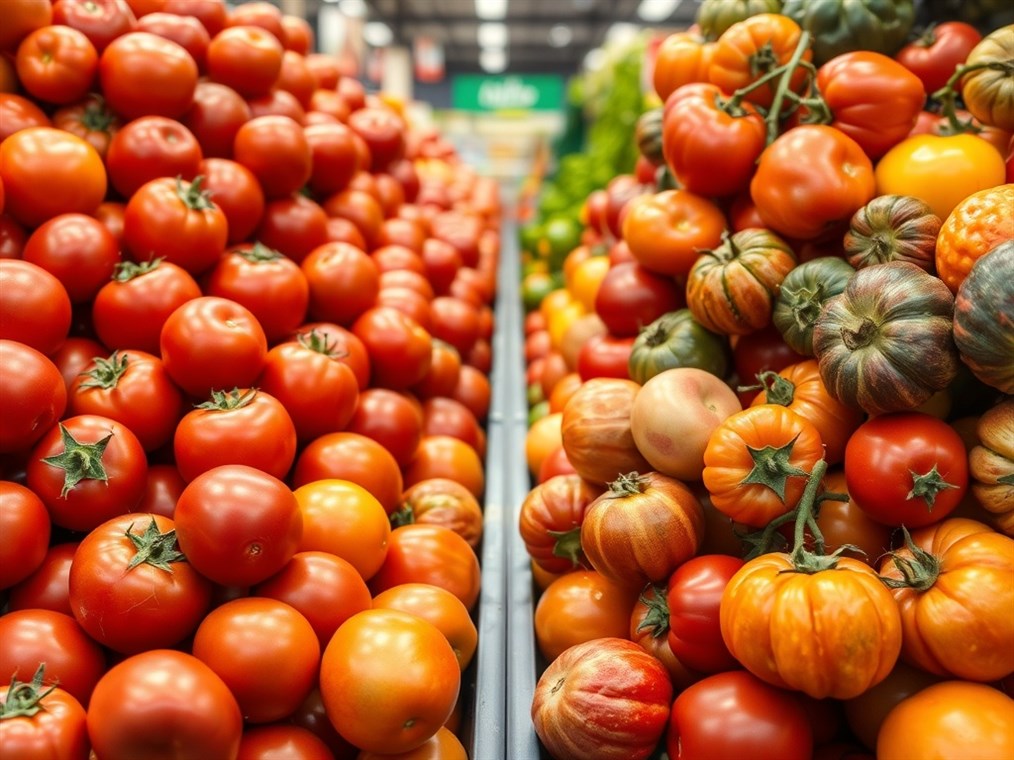Heirloom vs. Regular Tomatoes: What’s the Real Difference?
Okay, so you’re standing in the produce aisle, staring at a mountain of tomatoes. Red, round, and… pretty much the same, right? But then you spot them – the funky-looking ones, all different shapes and colors, labeled “heirloom.” What’s the deal? Are they worth the extra cash? Let’s dig in.
Forget those perfectly uniform supermarket tomatoes for a minute. We’re talking about a whole different ballgame when it comes to heirlooms. These aren’t your average, run-of-the-mill fruits. They’re like the antique furniture of the tomato world – each one with a story to tell.
So, what exactly makes a tomato an heirloom? Well, it’s not an exact science, but there are a few key things. First off, they’re open-pollinated. Think of it like this: instead of a breeder carefully choosing which plants get together, nature does its thing – bees buzzing around, wind blowing pollen. This means the seeds you save will (mostly) grow the same kind of tomato next year.
Now, how old does a tomato have to be to earn the “heirloom” title? Some say 50 years, some say before World War II. Either way, we’re talking about varieties that have been around the block. And often, these seeds have been passed down through families, like a treasured recipe or a well-worn quilt. It’s this passing down that gives them their “heirloom” status.
You’ll hear about different kinds of heirlooms too. There are the family heirlooms, the ones Grandma grew, and then there are the commercial heirlooms, which were sold way back when. Mystery heirlooms? Those are the happy accidents that pop up when different heirlooms cross-pollinate naturally. And finally, created heirlooms are when someone deliberately crosses two tomatoes and then spends years making sure the seeds grow true.
Now, let’s talk about those “regular” tomatoes – the hybrids. These are the result of plant breeders playing matchmaker, carefully crossing two different kinds of tomatoes to get the best of both worlds. Maybe one parent is super disease-resistant, and the other one ripens early. The hybrid gets both those traits!
The downside? If you save seeds from a hybrid, you won’t get the same tomato next year. It’s like baking a cake – you can’t just throw in random ingredients and expect it to taste the same.
Visually, this is where things get really interesting. Hybrid tomatoes? Usually pretty consistent: round, red, and about the same size. Heirloom tomatoes? Hold on to your hats! They come in every color imaginable – green, yellow, orange, pink, purple, brown, even striped! And the shapes? From tiny little cherries to giant, lumpy beefsteaks. Honestly, just looking at them is half the fun.
But let’s get to the good stuff: taste. This is where heirlooms really steal the show, in my opinion. While hybrids are often bred for things other than flavor (like how long they last on the shelf), heirlooms are all about the taste.
And what flavors! Sweet, tangy, earthy, smoky, even a little spicy. I swear, some of them taste like sunshine and summer. Hybrid tomatoes? They can be a little… bland. But hey, some newer hybrids are getting better in the flavor department.
Growing these guys is a whole different story. Hybrids are usually tougher, more disease-resistant, and give you a bigger harvest. That’s why farmers love them. Heirlooms can be a little more finicky. They might get sick easier, and you might not get as many tomatoes. But if you pick the right varieties for your area and give them some love, they’re totally worth it.
And here’s a cool thing: you can save the seeds from your heirloom tomatoes and grow the same kind next year! Can’t do that with hybrids.
Nutritionally, both are good for you. Packed with vitamins, minerals, and antioxidants. Tomatoes are famous for lycopene, which is supposed to be good for your heart. Some say heirlooms have more nutrients, but honestly, it depends on the tomato.
So, which tomato should you choose? It really comes down to what you’re looking for. If you want crazy flavor and cool-looking fruits, go for heirlooms. If you want something easy to grow and reliable, hybrids are a good bet.
Honestly, why not grow both? That way, you can have your perfectly round, red slicers for sandwiches and your funky, flavorful heirlooms for salads and sauces. Trust me, your taste buds will thank you.

